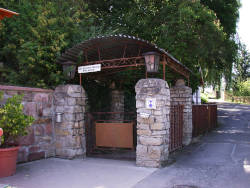Sandstein- und Märchenhöhle Walldorf
Sandstone Caves of Walldorf
Useful Information



| Location: |
Walldorf, 5 km north of Meiningen.
A4 exit Eisenach-Ost, B19 49 km towards Meiningen. A71 exit Meiningen Nord, B19 towards Eisenach. At Walldorf, at the Walldorf railroad station, turn off, across railroad tracks, follow the main road. Spitalstraße, turn right onto Invalidenstraße, turn right onto Thomas-Müntzer-Straße. Excess parking at the sports ground, 900m/10 min walk. (50.612194, 10.384811) |
| Open: |
APR to MAY daily 10-17, last tour 16. JUN to AUG daily 10-18, last tour 17. SEP to OCT daily 10-17, last tour 16. [2021] |
| Fee: |
Adults EUR 6, Children (3-14) EUR 3, Disabled EUR 5, Disabled Children (3-14) EUR 2.50, Family (2+2) EUR 16. Groups (20+): Adults EUR 5, Children (3-14) EUR 2.50. [2021] |
| Classification: |
 Rock Mine, Rock Mine,
 Sand Mine, Sand Mine,
 Room and Pillar Mining
Lower Triassic, Olenekium Room and Pillar Mining
Lower Triassic, Olenekium
|
| Light: |
 Incandescent Incandescent
|
| Dimension: | AR=65,000 m², 2,500 pillars, 300 m asl. |
| Guided tours: | L=800 m, D=30 min, St=0, V=100.000/a |
| Photography: | allowed |
| Accessibility: | no |
| Bibliography: |
Sandstein- und Märchenhöhle Walldorf,
Hrsg: Rat des Kreises Meiningen, Abteilung Kultur, Rat der Gemeinde Walldorf
|
| Address: |
Sandstein- und Märchenhöhle, Marienstraße 6, 98639 Walldorf, Tel: +37-3693-881277.
E-mail: |
| As far as we know this information was accurate when it was published (see years in brackets), but may have changed since then. Please check rates and details directly with the companies in question if you need more recent info. |
|
History
| 10th century | beginning of sand quarrying. |
| 1800 | first written account. |
| 1828 | documents about 12 Sandpächter (sand lessee). |
| 1902 | mushroom cultivation started in the cave. |
| 1912 | mushroom cultivation destroyed by mould and closed. |
| ~1919 | sand mining ended. |
| 1932 | opened to the public by a non-profit association. |
| ~1940 | visitor numbers fall, closed. |
| 09-JUN-1957 | opened to the public as a fairy grotto. |
Description




Sandstein- und Märchenhöhle Walldorf translates sandstone and fairy cave Walldorf, but this is literally wrong. The sandstone cave is not a cave at all, it is an underground quarry. Many inhabitants of the small village Walldorf once earned their living by mining a certain layer of the Lower Triassic. The Lower Triassic is called Buntsandstein (coloured sandstone) in Germany, because in this era Germany was a desert and the sediments are mostly reddish sandstones. Here a layer of white, fine grained sandstone was once deposited in a arid, desert-like climate. Above the village, this rock was once found on the surface. But when the people quarried more and more of this rock, they finally had to follow the layer underground. There was the danger of collapse, so they did the simplest thing possible, they mined in squares and left part of the layer untouched. The result is an enormous chamber of 65.000 m² with some 2.500 massive pillars. This kind of mining is called room and pillar method.
The sandstone was mined in handy pieces by the miner. At home his wife and children had to crush them to sand with a hammer. Although the rock was rather soft, there was some work necessary to get fine sand. The resulting sand was sieved and the sold in various fineness grades. The finest quality was used as blotting sand, an early predecessor of blotting paper. The coarser sand was used for rubbing and scouring, often in connection with soft soap.
The sand miners had to pay a rent to the government of Miningen, and on the other side the price for sand was rather low, Because of the low income and the hard work, this was always just an additional income, especially in bad times. The sand sellers had to walk far to sell it, and they were considered peddlers. To tell people what they had to sell, they sang a song.
er hat so schönen weißen Sand,
ist allen Leuten wohlbekannt...
The sandman is here,
he has such beautiful white sand,
is well known to all people...
The trail through this cavern is often very low, sometimes less than 1.50 m. The floor is made of earth, and often has ripple marks. Please wear sturdy shoes and be careful. The first part of the tour explains the geologic and historic background of the caverns. There are historic tools and even scenes of sand making.
To include a sort of fairy park into the mine to make it more interesting is rather uncommon for Germany. It is a typical thing for Britain and other Anglo-Saxon countries. The rooms between the pillars were used as alkovens, each telling another fairy tale. The fairy tales are of German origin: by the brothers Grimm, Ludwig Bechstein and Hans Christian Andersen. Other scenes show the Sandmännchen (sand man) from the GDR TV programm, which became cult after the end of the GDR. Other scenes show Max and Moritz from the early cartoon A Story of Seven Boyish Pranks by Wilhelm Busch. With the little zoo and the restaurants, this is definitely a family destination, intended for young children.
 Search DuckDuckGo for "Sandstein- und Märchenhöhle Walldorf"
Search DuckDuckGo for "Sandstein- und Märchenhöhle Walldorf" Google Earth Placemark
Google Earth Placemark Märchen- und Sandsteinhöhle
Märchen- und Sandsteinhöhle  - Wikipedia (visited: 15-MAY-2021)
- Wikipedia (visited: 15-MAY-2021) Sandstein- und Märchenhöhle Walldorf, official website. (
Sandstein- und Märchenhöhle Walldorf, official website. ( Index
Index Topics
Topics Hierarchical
Hierarchical Countries
Countries Maps
Maps